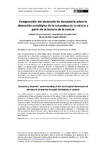Mostrar o rexistro simple do ítem
Comprensión de estudiantes de Secundaria sobre la dimensión sociológica de la naturaleza de la ciencia a partir de la historia de la ciencia
| dc.contributor.author | García-Carmona, Antonio | |
| dc.contributor.author | Acevedo-Díaz, José Antonio | |
| dc.contributor.author | Aragón Méndez, María del Mar | |
| dc.date.accessioned | 2019-02-18T13:00:22Z | |
| dc.date.available | 2019-02-18T13:00:22Z | |
| dc.date.issued | 2018 | |
| dc.identifier.citation | Ápice. Revista de Educación Científica, 2018,2, 2: 43-54. ISSN: 2531-016X | es_ES |
| dc.identifier.issn | 2531-016X | |
| dc.identifier.uri | http://hdl.handle.net/2183/21835 | |
| dc.description.abstract | [Resumen] Este artículo presenta un meta-análisis de los resultados de tres estudios cualitativos sobre la comprensión de la dimensión sociológica de la naturaleza de la ciencia (NDC), usando tres casos de historia de la ciencia (HDC): “Semmelweis y la fiebre puerperal”, “La controversia entre Pasteur y Pouchet sobre la generación espontánea” y “Rosalind Franklin y la elucidación de la estructura del ADN”. Los tres estudios fueron llevados a cabo con alumnado de Educación Secundaria (4º de ESO, 1º de Bachillerato y 2º de Bachillerato) mediante una estrategia basada en la reflexión crítica y el debate sobre cuestiones de NDC. El meta-análisis se concretó en determinar las referencias del alumnado en sus respuestas argumentadas a los descriptores de sociología de la ciencia, establecidos en las rúbricas empleadas para la evaluación. Se concluye que el alumnado de Educación Secundaria, en general, mejoró su comprensión sobre la influencia de aspectos sociológicos en el desarrollo de la ciencia, a partir de la reflexión y discusión crítica en torno a los casos de HDC seleccionados | es_ES |
| dc.description.abstract | [Abstract] This article presents a meta-analysis of the results from three qualitative studies on the understanding of the sociological dimension of the nature of science (NOS) using three cases of the history of science (HOS): “Semmelweis and the childbed fever”, “The controversy between Pasteur and Pouchet on spontaneous generation”, and “Rosalind Franklin and the elucidation of the structure of DNA”. The three studies were conducted with secondary school students (15-18 years old) through a strategy based on critical reflection and debate on NOS issues. The analysis focused on determining the students’ references to the sociology of science descriptors, according to the assessment rubrics employed, that they included in their argued responses. It is concluded that the secondary students improved their understanding of how the sociological aspects influence the science development through the reflection and critical discussion around the HOS cases that were selected | es_ES |
| dc.language.iso | spa | es_ES |
| dc.rights | Atribución-CompartirIgual 3.0 España | es_ES |
| dc.rights.uri | http://creativecommons.org/licenses/by-sa/3.0/es/ | * |
| dc.subject | Educación secundaria | es_ES |
| dc.subject | Historia de la ciencia | es_ES |
| dc.subject | Naturaleza de la ciencia | es_ES |
| dc.subject | Sociología de la ciencia | es_ES |
| dc.subject | History of science | es_ES |
| dc.subject | Nature of science | es_ES |
| dc.subject | Secondary education | es_ES |
| dc.subject | Sociology of science | es_ES |
| dc.title | Comprensión de estudiantes de Secundaria sobre la dimensión sociológica de la naturaleza de la ciencia a partir de la historia de la ciencia | es_ES |
| dc.title.alternative | Secondary students’ understanding of the sociological dimension of the nature of science through the history of science | es_ES |
| dc.type | info:eu-repo/semantics/article | es_ES |
| dc.rights.access | info:eu-repo/semantics/openAccess | es_ES |
| UDC.journalTitle | Ápice. Revista de Educación Científica | es_ES |
| UDC.startPage | 43 | es_ES |
| UDC.endPage | 54 | es_ES |
| dc.identifier.doi | https://doi.org/10.17979/arec.2018.2.2.4519 |






